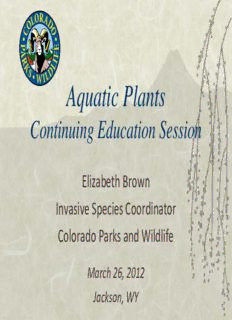
Aquatic Plant Identification Focus on Aquatic Weeds PDF
Preview Aquatic Plant Identification Focus on Aquatic Weeds
Aquatic Plants Continuing Education Session Elizabeth Brown Invasive Species Coordinator Colorado Parks and Wildlife March 26, 2012 Jackson, WY Aquatic Plants Overview Session Agenda Identification • Floating • Submerged • Emergent Survey Methods Management / Control Options Additional Resources True aquatic plants are defined as plants that are normally, comDpleetefliyn ori tmioostnly ssu bmerged in water and are unable to survive for long periods outside that medium. This definition includes floating, as well as rooted aquatic species. • MN DNR “A Guide to Aquatic Plants” Aquatic Nuisance Species (ANS) are defined as fish, animal and plant species that have been introduced into new ecosystems throughout the USA. These exotic species are having harmful impacts on natural resources and the human use of these resources. • ANS Task Force “On a global basis…the two great destroyers of biodiversity are first, habitat destruction and second, invasion by exotic species” E.O. Wilson Types of Aquatic Plants Aquatic macrophytes Role of Aquatic Plants benefit the system as: • A source of dissolved oxygen (O ) 2 • A sink for Carbon Dioxide (CO ) 2 • Bank, bed and shoreline protection •Habitat for macroinvertebrates and fish • Food for waterfowl and animals • Nutrient cycling and slowing of sediment transport Why Are Native Aquatic Plants Plants are the foundation of life that without other organisms Good For Fish? can’t survive. Plants keep the water oxygenated, provide food, cover and nesting sites and stabilize the shoreline and bottom. Most fish don't actually eat aquatic plants; instead, they eat other organisms--microscopic animals, aquatic insects, crayfish and frogs--that either eat plants themselves or live on or around them. Beds of vegetation give young fish a place to hide from predators. Without such escape cover, few would survive long enough to grow to a larger size. Aquatic plant beds also provide good fishing spots, because they attract adults of most fish species. How Many Plants Are Too Many? Depends on the water body size and type of fishery. There should be a narrow band of underwater and emergent plants around much of the water's edge. These plants will stabilize the shoreline and attract fish from deeper water. ~10-20% cover in ponds and small lakes ~10-30% cover in larger lakes and reservoirs Literature varies – Know Your Site! When Do Too Many Plants Exotic, No Predators, Invasives! Become A Problem? Excessive aquatic vegetation may cause… • Fish kills– oxygen depletion from large plant beds (as sunlight decreases, plants use more oxygen than they produce or decaying plants utilizing oxygen to break down) • Alteration of the balance of the fish community by providing too much escape cover for young fish • Alteration of the spawning mechanisms in deeper waters • Physical interference with the intended use of a lake or pond, such as boating, swimming, fishing, irrigation or livestock watering. Maintaining the balance of The Goal beneficial native aquatic plant species to support fisheries, waterfowl, other wildlife and recreational opportunities.
Description: